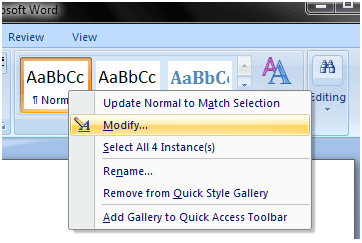Mastering Style Customization in Microsoft Word: A Comprehensive Guide

Introduction:
Microsoft Word stands as one of the most widely used word processing applications globally, offering a plethora of features to enhance document creation and formatting. Among its powerful tools, the ability to customize styles serves as a cornerstone for achieving consistency, professionalism, and efficiency in document design. In this comprehensive guide, we embark on a journey to master the art of customizing styles in Microsoft Word, exploring techniques, tips, and best practices to create visually appealing and cohesive documents tailored to specific needs and preferences.
Understanding the Importance of Style Customization:
Styles in Microsoft Word play a pivotal role in document formatting, providing a systematic approach to organizing and formatting text, paragraphs, and other elements. The importance of style customization can be attributed to several key factors:
- Consistency: Customizing styles ensures uniformity in document formatting, allowing for consistent fonts, colors, spacing, and other design elements throughout the document.
- Efficiency: By creating and customizing styles, users can streamline the formatting process, saving time and effort when applying formatting changes to multiple sections or documents.
- Professionalism: Well-designed styles contribute to the overall professionalism and readability of documents, enhancing the visual appeal and credibility of the content.
- Accessibility: Customized styles improve document accessibility by enhancing readability for users with visual impairments or specific reading preferences, such as larger fonts or increased spacing.
Now, let’s delve into the various aspects of style customization in Microsoft Word:
Understanding Built-in Styles:
Microsoft Word comes pre-loaded with a variety of built-in styles, ranging from basic text formatting to more advanced heading styles and thematic designs. Understanding these built-in styles forms the foundation for customizing styles in Word:
- Normal Text: The default style for body text, often used for standard paragraphs and content.
- Heading Styles: Word offers several predefined heading styles (Heading 1, Heading 2, etc.), which are commonly used for section headings and subheadings to create hierarchical document structures.
- List Styles: Word provides built-in styles for numbered lists, bulleted lists, and multilevel lists, allowing for consistent formatting of list items.
- Character Styles: These styles apply formatting to individual characters or words within a paragraph, such as bold, italic, underline, or color.
Customizing Built-in Styles:
Microsoft Word allows users to customize existing styles or create new ones to suit specific design preferences and document requirements. Here’s how to customize built-in styles:
- Accessing the Styles Pane: To access the Styles pane in Word, navigate to the “Home” tab, then click the “Styles” dialog box launcher in the Styles group. Alternatively, use the shortcut “Ctrl + Alt + Shift + S” to open the Styles pane.
- Modifying Styles: In the Styles pane, locate the style you wish to modify (e.g., Heading 1, Normal, etc.). Right-click on the style name and select “Modify” from the context menu. A dialog box will appear, allowing you to customize various aspects of the style, such as font, size, color, spacing, and indentation.
- Applying Changes: After customizing the style settings, click “OK” to apply the changes to the selected style. Any text or elements formatted with the modified style will update automatically to reflect the changes.
Creating New Styles:
In addition to modifying built-in styles, users can create new styles from scratch to meet specific design requirements. Here’s how to create a new style in Microsoft Word:
- Accessing the Styles Pane: Open the Styles pane using the methods described earlier.
- Opening the Styles Dialog: At the bottom of the Styles pane, click on the “New Style” button. Alternatively, right-click anywhere in the document and select “Styles” > “New Style” from the context menu.
- Defining Style Properties: In the New Style dialog box, enter a name for the new style and specify the desired formatting properties, including font, size, color, alignment, spacing, and indentation.
- Applying the New Style: Once the new style is defined, click “OK” to create the style. The new style will now appear in the Styles pane and can be applied to text or elements in the document.
Advanced Style Customization Techniques:
In addition to basic style customization, Microsoft Word offers advanced techniques for fine-tuning styles and achieving precise formatting:
- Style Sets and Themes: Word provides predefined style sets and themes, allowing users to quickly apply coordinated sets of styles to documents for a cohesive look and feel.
- Based On Styles: Users can create hierarchical relationships between styles by specifying a “Based On” style when defining a new style. This allows for consistent formatting across related styles and facilitates easy updates.
- Style Organizer: The Style Organizer tool in Word enables users to manage and organize styles, including copying, renaming, and deleting styles, as well as importing styles from other documents.
- Quick Style Gallery: Word’s Quick Style Gallery provides quick access to commonly used styles, allowing users to apply formatting changes with a single click.
Conclusion:
In conclusion, mastering style customization in Microsoft Word is essential for achieving consistency, professionalism, and efficiency in document design. By understanding the importance of styles, exploring built-in styles, and learning how to customize and create new styles, users can create visually appealing and cohesive documents tailored to their specific needs and preferences. Whether formatting text, paragraphs, lists, or headings, Microsoft Word offers a range of tools and features for achieving precise styling and formatting results. With practice, experimentation, and attention to detail, users can harness the power of style customization to elevate their document designs and create compelling content with confidence and ease.




